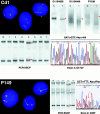Mutations and allelic deletions of the MEN1 gene are associated with a subset of sporadic endocrine pancreatic and neuroendocrine tumors and not restricted to foregut neoplasms
- PMID: 10027401
- PMCID: PMC1849990
- DOI: 10.1016/S0002-9440(10)65289-3
Mutations and allelic deletions of the MEN1 gene are associated with a subset of sporadic endocrine pancreatic and neuroendocrine tumors and not restricted to foregut neoplasms
Abstract
Endocrine pancreatic tumors (EPT) and neuroendocrine tumors (NET) occur sporadically and rarely in association with multiple endocrine neoplasia type 1 (MEN1). We analyzed the frequency of allelic deletions and mutations of the recently identified MEN1 gene in 53 sporadic tumors including 30 EPT and 23 NET (carcinoids) of different locations and types. Allelic deletion of the MEN1 locus was identified in 18/49 (36.7%) tumors (13/30, 43.3% in EPT and 5/19, 26.3% in NET) and mutations of the MEN1 gene were present in 8/52 (15.3%) tumors (4/30 (13.3%) EPT and 4/22 (18.1%) NET). The somatic mutations were clustered in the 5' region of the coding sequence and most frequently encompassed missense mutations. All tumors with mutations exhibited a loss of the other allele and a wild-type sequence of the MEN1 gene in nontumorous DNA. In one additional patient with a NET of the lung and no clinical signs or history of MEN1, a 5178-9G-->A splice donor site mutation in intron 4 was identified in both the tumor and blood DNA, indicating the presence of a thus far unknown MEN1 syndrome. In most tumor groups the frequency of allelic deletions at 11q13 was 2 to 3 times higher than the frequency of identified MEN1 gene mutations. Some tumor types, including rare forms of EPT and NET of the duodenum and small intestine, exhibited mutations more frequently than other types. Furthermore, somatic mutations were not restricted to foregut tumors but were also detectable in a midgut tumor (15.2% versus 16.6%). Our data indicate that somatic MEN1 gene mutations contribute to a subset of sporadic EPT and NET, including midgut tumors. Because the frequency of mutations varies significantly among the investigated tumor subgroups and allelic deletions are 2 to 3 times more frequently observed, factors other than MEN1 gene inactivation, including other tumor-suppressor genes on 11q13, may also be involved in the tumorigenesis of these neoplasms.
Figures

References
-
- Williams ED, Sandler M: The classification of carcinoid tumors. Lancet 1963, 1:238-239 - PubMed
-
- Modlin IM, Sandor A: An analysis of 8305 cases of carcinoid tumors. Cancer 1997, 79:813-829 - PubMed
-
- Grimelius L, Hultquist G, Steinkvist B: Cytological differentiation of asymptomatic pancreatic islet cell tumours in autopsy material. Virchows Arch A 1975, 365:275-288 - PubMed
-
- Klöppel G, In’t Veld P, Komminoth P, Heitz PU: The endocrine pancreas. Kovacs K Asa SL eds. Functional Endocrine Pathology. 1998, :pp 415-487 Blackwell Scientific Publications, Oxford
-
- Chandrasekharappa SC, Guru SC, Manickam P, Olufemi S, Collins FS, Emmert-Buck MR, Debelenko LV, Zhuang Z, Lubensky IA, Liotta LA, Crabtree JS, Wang Y, Roe BA, Weisemann J, Boguski MS, Agarwal SK, Kester MB, Kim YS, Heppner C, Dong Q, Spiegel AM, Burns AL, Marx SJ: Positional cloning of the gene for multiple endocrine neoplasia-type 1. Science 1997, 276:404-406 - PubMed
Publication types
MeSH terms
Substances
LinkOut - more resources
Full Text Sources
Other Literature Sources
Medical

